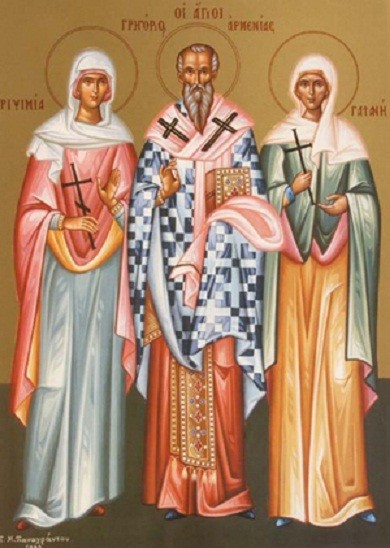 Saint Ripsimia had fled to Armenia, together with her hegumeness and fellow sisters, to avoid entering into marriage with the emperor Diocletian (284-305), who was charmed by her beauty. Concerning this, Diocletian sent a report to the Armenian emperor Tiridates suggesting that he either send Ripsimia back, or wed her himself. The servants of the emperor found the fugitives and they began to urge Ripsimia to submit to the will of the emperor. The saint answered, that she, just like all her monastic sisters, was betrothed to the Heavenly Bridegroom and so to enter into marriage was not possible. Then from the heavens resounded a Voice: "Be brave and fear not, for I am with thee". The messengers in fear withdrew. Tiridates gave the maiden over to cruelest torments: they plucked out her tongue, cut open her stomach, blinded and killed her, chopping her body into pieces. After this, inspired by Ripsimia to bravely endure torments for Christ, the hegumeness Saint Gaiania and two other monastic sisters were given over to similar tortures, after which they were beheaded. The remaining 33 sisters were run through with swords and their bodies thrown for devouring by wild beasts. The wrath of God befell emperor Tiridates, and likewise those of his associates and soldiers, who had participated in the tormenting of the saints. Beset by demons, they became like wild boars (as once with Nebuchadnessar, Dan. 4: 30), ranging through the forests, rending their clothes and gnawing at their own bodies. After the passage of a certain while, it was announced in a dream to Tiridates' sister Kusarodukhta: "If Gregory be not taken out of the pit, emperor Tiridates will not be healed". Then those close to the emperor approached the pit and asked: "Gregory, art thou alive?" Gregory answered: "By the grace of my God I am alive". Then they brought out the holy martyr – unshaven, darkened and very withered, but as before steadfast of spirit.
Saint Ripsimia had fled to Armenia, together with her hegumeness and fellow sisters, to avoid entering into marriage with the emperor Diocletian (284-305), who was charmed by her beauty. Concerning this, Diocletian sent a report to the Armenian emperor Tiridates suggesting that he either send Ripsimia back, or wed her himself. The servants of the emperor found the fugitives and they began to urge Ripsimia to submit to the will of the emperor. The saint answered, that she, just like all her monastic sisters, was betrothed to the Heavenly Bridegroom and so to enter into marriage was not possible. Then from the heavens resounded a Voice: "Be brave and fear not, for I am with thee". The messengers in fear withdrew. Tiridates gave the maiden over to cruelest torments: they plucked out her tongue, cut open her stomach, blinded and killed her, chopping her body into pieces. After this, inspired by Ripsimia to bravely endure torments for Christ, the hegumeness Saint Gaiania and two other monastic sisters were given over to similar tortures, after which they were beheaded. The remaining 33 sisters were run through with swords and their bodies thrown for devouring by wild beasts. The wrath of God befell emperor Tiridates, and likewise those of his associates and soldiers, who had participated in the tormenting of the saints. Beset by demons, they became like wild boars (as once with Nebuchadnessar, Dan. 4: 30), ranging through the forests, rending their clothes and gnawing at their own bodies. After the passage of a certain while, it was announced in a dream to Tiridates' sister Kusarodukhta: "If Gregory be not taken out of the pit, emperor Tiridates will not be healed". Then those close to the emperor approached the pit and asked: "Gregory, art thou alive?" Gregory answered: "By the grace of my God I am alive". Then they brought out the holy martyr – unshaven, darkened and very withered, but as before steadfast of spirit.If you like our project and you are satisfied with our work and effort, please consider making a donation that would help us to survive on the Internet and in further development of the project.
There are many other ways to help...